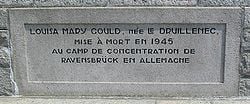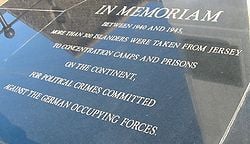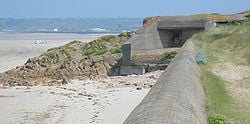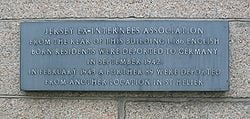Occupation of the Channel Islands by Nazi Germany

The Occupation of the Channel Islands refers to the military occupation of the Channel Islands by the Third Reich during World War II which lasted from June 30, 1940, until the Liberation on May 9, 1945. The Channel Islands comprise the crown dependencies of the bailiwicks of Guernsey and Jersey, and also take in the smaller islands, of Alderney and Sark. These were the only portions of the British Isles to be invaded and occupied by German forces during the war.
The islands were too small to serve as a launching pad for an invasion of Britain, and once Germany had lost the battle for air supremacy, the intended invasion never took place. The occupation did, however, boost German morale. It also had significant propaganda value. On the one hand, some islanders were courageous in defying the occupiers. On the other hand, questions remain about the extent to which other islanders were complicit in persecuting the Jewish community. The occupation brought tyranny close to Britain's shores. As the "lights" went out across Europe, this only made the population of Britain more determined to defeat Hitler in defense of freedom and democracy. Having made the strategic decision not to defend the island, the British were determined that no more territory would be conceded. However great the sacrifice, the enemy had to be defeated.
Before occupation
Demilitarization
On June 15, 1940, the British Government decided that the Channel Islands were of no strategic importance and would not be defended. They decided to keep this a secret from the German forces. London had decided that the Channel Islands would be little more than a drain of resources for the Germans. So, in spite of the reluctance of Prime Minister Winston Churchill, the British Government gave up the oldest possession of the Crown without firing "a single shot."[2] The tens of thousands of German soldiers that Adolf Hitler was to send to defend the Islands could not be sent to defend more strategically important sites, such as the West coast of Europe. The Channel Islands served no purpose to the Germans other than the propaganda value of having occupied some British territory. The "Channel Islands [had] been demilitarized and declared…'open town'."[3] Hitler, however, was "immensely proud of his British conquest."[4]
Evacuation
The British Government consulted the Islands' elected government representatives, in order to formulate a policy regarding evacuation. Opinion was divided and, without a policy being imposed on the Islands, chaos ensued and different policies were adopted by the different islands. The British Government concluded their best policy was to make available as many ships as possible so that Islanders had the option to leave if they wanted to. The authorities on Alderney recommended that all islanders evacuate, and nearly all did so; Sybil Mary Hathaway, Dame of Sark, encouraged everyone to stay. Guernsey evacuated all children of school age, giving the parents the option of keeping their children with them, or evacuating with their school. In Jersey, the majority of Islanders chose to stay.
Invasion
Since the Germans were ignorant of the fact that the Islands had been demilitarized, they approached the islands with some caution. Reconnaissance flights were inconclusive. On June 28, 1940, they sent a squadron of bombers on a mission over the Islands and bombed the harbors of Guernsey and Jersey. In St Peter Port, what the reconnaissance mistook for troop carriers were actually lines of lorries queued up to load tomatoes for export to England. Forty-four islanders were killed in the raids.
While the German Army was preparing to land an assault force of two battalions to capture the Islands, a reconnaissance pilot landed in Guernsey on June 30, to whom the Island officially surrendered. Jersey surrendered on July 1. Alderney, where only a handful of islanders remained, was occupied on July 2, and a small detachment traveled from Guernsey to Sark, which officially surrendered on July 4.
Occupation
The German forces quickly consolidated their positions. They brought in infantry, established communications and anti-aircraft defenses, established an air service with mainland France and rounded up British servicemen on leave.
Government
In Guernsey, the Bailiff, Sir Victor Carey and the States of Guernsey handed overall control to the German authorities. Day-to-day running of Island affairs became the responsibility of a Controlling Committee, chaired by Ambrose Sherwill.
Scrip (occupation money) was issued in Guernsey to keep the economy going. German military forces used their own scrip for payment of goods and services.
Resistance and collaboration

Louisa Gould hid a wireless set and sheltered an escaped Russian prisoner. Betrayed by an informer at the end of 1943, she was arrested and sentenced June 22, 1944. In August 1944, she was transported to Ravensbrück and murdered in the gas chambers there February 13, 1945.
There was no resistance movement in the Channel Islands on the scale of that in mainland France. This has been ascribed to a range of factors including the physical separation of the Islands, the density of troops (up to one German for every two Islanders), the small size of the Islands precluding any hiding places for resistance groups and the absence of the Gestapo from the occupying forces. Moreover, much of the population of military age had joined the British Army already.
Resistance was often "passive,"[5] acts of minor sabotage, sheltering and aiding escaped slave workers and publishing underground newspapers containing news from BBC radio. The islanders also joined in the Churchill's V sign campaign by daubing the letter "V" (for Victory) over German signs. A widespread form of passive resistance (albeit taking place in secret within the confines of Islanders homes) was the act of listening to BBC radio, which was banned in the first few weeks of the occupation and then (surprisingly, given the policy elsewhere in Nazi-occupied Europe) tolerated for a period before being once again prohibited. Later, the ban became even more draconian with all radio listening (even to German stations) being banned by the occupiers backed up by the widespread confiscation of wireless sets. Nevertheless, many Islanders successfully hid their radios (or replaced them with homemade crystal sets) and continued listening to the BBC despite the risk of being discovered by the Germans or being informed on by neighbors.
A number of Islanders escaped (including Peter Crill), the pace of which increased following D-Day, when conditions in the Islands worsened as supply routes to the continent were cut off and the desire to join in the liberation of Europe increased.
The policy of the Island governments, acting under instructions from the British government communicated before the occupation, was one of passive resistance,[6][5] although this has been criticized, particularly in the treatment of Jews in the islands. Fraser contends that "the most prominent members of the islands' governmental and legal systems, from the Bailiffs, Alexander Coutanche and Victor Carey, to their respective Attorneys-General … actively and willingly enforced these pernicious legal provisions without question and sometimes with apparent enthusiasm."[7] The remaining Jews on the Islands, often Church of England members with one or two Jewish grandparents, were subjected to the nine Orders Pertaining to Measures Against the Jews, including closing of their businesses (or placing them under Aryan administration), giving up their wirelesses, and staying indoors for all but one hour per day. These measures, as Fraser says, were administered by the Bailiff and the Aliens Office. On the other hand, Stephenson and Taylor argue that despite Nazi attempts to "influence the civilian population with … anti-semitic propaganda, there is little evidence that islanders were stimulated into denouncing suspect Jews." Two residents, they say, "are known to have sheltered individual Jews … for expended periods."[6]
Some island women fraternized with the occupying forces, although this was frowned upon by the majority of Islanders, who gave them the derogatory nickname "Jerry-bag."
The lack of currency in Jersey led to a request to artist Edmund Blampied to design scrip for the States of Jersey in denominations of 6 pence, 1 shilling, 2 shillings, 10 shillings and 1 pound, which were issued in 1942. A year later he was asked to design six new postage stamps for the island of ½ d to 3 d and, as a sign of resistance, he cleverly incorporated the initials GR in the three penny stamp to display loyalty to King George VI.
A few islanders actually joined German units; "Eric Pleasants and John Leister both joined the British Friekorps; and Eddie Chapman became a double agent."[8]
British Government reaction
The British Government's reaction to the German invasion was muted, with the Ministry of Information issuing a press release shortly after the Germans landed.
On July 6, 1940, 2nd Lieutenant Hubert Nicolle, a Guernseyman serving with the British Army, was dispatched on a fact-finding mission to Guernsey. He was dropped off the south coast of Guernsey by a submarine and rowed ashore in a canoe under cover of night. This was the first of two visits which Nicolle made to the island. Following the second, he missed his rendezvous and was trapped on the island. After a month and a half in hiding, he gave himself up to the German authorities and was sent to a German prison-of-war camp.
On the night of July 14, 1940, Operation Ambassador, was launched on the German occupied island of Guernsey by men drawn from H Troop of No.3 Commando under John Durnford-Slater and No.11 Independent Company. The raiders failed to make contact with the German garrison.
In October 1942, there was a British Commando raid on Sark, named Operation Basalt.
In 1943, Vice Admiral Lord Mountbatten proposed a plan to retake the islands named Operation Constellation. The proposed attack was never mounted.
Fortification
As part of the Atlantic Wall, between 1940 and 1945, the occupying German forces and the Organisation Todt constructed fortifications round the coasts of the Channel Islands.
The majority of the workforce constructing bunkers were German soldiers (photo evidence recorded) although around one thousand Russian soldiers were also used as slave labor.
In Alderney, a concentration camp, Lager Sylt, was established to provide slave labor for the fortifications.
The Channel Islands were amongst the most heavily fortified, particularly the island of Alderney which is the closest to France. Hitler had decreed that 10 percent of the steel and concrete used in the Atlantic Wall go to the Channel Islands, because of the propaganda value of controlling British territory.
Deportation
In 1942, the German authorities announced that all residents of the Channel Islands who were not born in the Islands, as well as those men who had served as officers in World War I, were to be deported. The majority of them were transported to the southwest of Germany, notably to Ilag V-B at Biberach an der Riss and Ilag VII at Laufen. This deportation decision came directly from Adolf Hitler, as a reprisal for German civilians in Iran being deported and interned.[4] The ratio was twenty Channel Islanders to be interned for every one German interned.
Representation in London
As self-governing Crown Dependencies, the Channel Islands had no elected representatives in the British Parliament. In order to ensure that the Islanders were not forgotten, it fell to evacuees and other Islanders living in the United Kingdom prior to the occupation. The Jersey Society in London, formed in the 1920s, provided a focal point for exiled Jerseymen. In 1943, a number of influential Guernseymen living in London formed the Guernsey Society to provide a similar focal point and network for Guernsey exiles. Besides relief work, these groups also undertook studies to plan for economic reconstruction and political reform after the end of the war. The pamphlet Notre Île published in London by a committee of Jersey people was influential in the 1948 reform of the constitution of the Bailiwick.
Bertram Falle, a Jerseyman, was elected Member of Parliament (MP) for Portsmouth in 1910. Eight times elected to the House of Commons, in 1934 he was raised to the House of Lords with the title of Lord Portsea. During the occupation he represented the interests of Islanders and pressed the British government to relieve their plight, especially after the Islands were cut off after D-Day.
Committees of émigré Channel Islanders elsewhere in the British Empire also banded together to provide relief for evacuees. For example, Philippe William Luce (writer and journalist, 1882–1966) founded the Vancouver Channel Islands Society in 1940 to raise money for evacuees.
Under siege
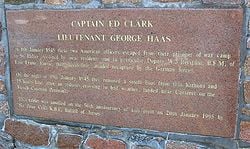
During June 1944, the Allied Forces launched the D-Day landings and the liberation of Normandy. They decided to bypass the Channel Islands due to the heavy fortifications constructed by German Forces. However, the consequence of this was that German supply lines for food and other supplies through France were completely severed. The Islanders' food supplies were already dwindling, and this made matters considerably worse—the islanders and German forces alike were on the point of starvation. On the other hand, Germans stationed on the islands "never had to do any fighting" and were "not surrounded by an overtly hostile population."[6]
Churchill's reaction to the plight of the German garrison was to "let 'em rot," even though this meant that the Islanders had to rot with them. It took months of protracted negotiations before the International Red Cross ship SS Vega was permitted to rescue the starving Islanders in December 1944, bringing Red Cross food parcels, salt, and soap, as well as medical and surgical supplies. The Vega made five further trips to the Islands before liberation in May 1945.
In 1944, the popular German film actress Lil Dagover arrived on the Channel Islands to entertain German troops on the islands of Jersey and Guernsey with a theater tour to boost morale.
The Granville Raid occurred on the night of March 8–March 9, 1945 when a German raiding force from the Channel Islands successfully landed and brought back supplies to their base.[5]
Liberation and legacy
Liberation
Although plans had been drawn up and proposed by Vice Admiral Lord Louis Mountbatten, in 1943, for Operation Constellation, a military reconquest of the islands, it was not to be. The Channel Islands were liberated after the German surrender.

On May 8, 1945, at 10 a.m., the islanders were informed by the German authorities that the war was over. Winston Churchill made a radio broadcast at 3 p.m. during which he announced that:
Hostilities will end officially at one minute after midnight to-night, but in the interests of saving lives the "Cease fire" began yesterday to be sounded all along the front, and our dear Channel Islands are also to be freed to-day.[9]
The following morning, May 9, 1945, HMS Bulldog arrived in St Peter Port, Guernsey and the German forces surrendered unconditionally aboard it at dawn. British forces landed in St Peter Port shortly after, greeted by crowds of joyous but malnourished islanders.
HMS Beagle, which had set out at the same time from Plymouth performed a similar role in liberating Jersey.
It appears that the first place liberated on Jersey might have been the British General Post Office Jersey repeater station. Mr. Warder, a GPO linesman, had been stranded on the island during the occupation. He did not wait for the island to be liberated and went to the repeater station where he informed the German officer in charge that he was taking over the building on behalf of the British Post Office.[10]
Legacy
The Nazi occupation of the Channel islands brought the Third Reich and its tyranny as close to the British mainland as it could go without invading Britain. The islands, however, were too small to act as a staging post for a sea-invasion of Britain. Hitler believed that before a successful invasion could be launched, Germany needed to gain supremacy in the air. This is why so much effort was invested in attempting to win the Battle of Britain. The occupation almost certainly further fueled British determination that no other British territory would be conceded. That, however, was won by the British. If the British had lost, the war may have taken a different direction. The U.S. may not have entered on the side of the British, despite Franklin D. Roosevelt's personal relationship with Churchill. Some islanders cooperated with the Nazis but "at the other extreme there were acts of immense personal courage in defying the occupiers."[6]
On the other hand, controversy continues about the level of collaboration in carrying out anti-Jewish laws. Fraser says that the islanders were "complicit" in the "persecution of Jews" and that "collective memory" refuses to acknowledge this.[7] He goes so far as to claim that the "terror to which Jews were subjected on a daily basis" during the occupation was almost entirely "an internal, local phenomenon."[7] Alongside the Bombing of Hiroshima and Nagasaki and the Bombing of Dresden complicity in the persecution of Jews by some Channel Islanders during the Nazi occupation shows that, even though the Allied Powers did not commit crimes on the scale of that the Axis Powers did, their copy book also contains some blotted pages.
Literary legacy
- Since the end of the occupation, the anniversary of Liberation Day (May 9) has been celebrated as a National holiday. But in Alderney there was no official local population to be liberated, so Alderney celebrates "Coming home day" to commemorate the return of the evacuated population.
- Many islanders and evacuees have published their memoirs and diaries of this period.
- The Channel Islands Occupation Society was formed in order to study and preserve the history of this period.[11]
- A number of documentaries have been made about the Occupation, mixing interviews with participants, both Islanders and soldiers, archive footage, photos and manuscripts and modern day filming around the extensive fortifications still in place. These films include:
- High Tide Productions—52min documentary tracing the history of the Occupation following the discovery of a notebook in an attic in Guernsey belonging to a German soldier named Toni Kumpel.[12]
- There have also been a number of TV and film dramas set in the occupied Islands:
- ITV's Enemy at the Door, set in Guernsey and shown between 1978 and 1980.
- ITV's Island at War (2004), a drama set in the fictional Channel Island of St Gregory. It was shown by U.S. TV network PBS as part of their Masterpiece Theatre series in 2005.
- The 2001 film, The Others starring Nicole Kidman was set in Jersey in 1945 just after the end of the occupation.* A stage play, Dame of Sark by William Douglas-Home is set in the island of Sark during the German Occupation, and is based on the Dame's diaries of this period.
- The following novels have been set in the German-occupied islands:
- Higgins, Jack. 1970. A Game for Heroes. New York: Berkley. ISBN 0440132622
- Binding, Tim. 1999. Island Madness. London: Picador. ISBN 0330350463
- Link, Charlotte. 2000. Die Rosenzüchterin. (The Rose Breeder), condensed ed., Köln: BMG-Wort. ISBN 3898301257
- Parkin, Lance. 1996. Just War. New Doctor Who adventures series. London: Doctor Who Books. ISBN 0426204638
- Robinson, Derek. 1977. Kramer's War. London: Hamilton. ISBN 0241895782
- Tickell, Jerrard. 1976. Appointment with Venus. London: Kaye and Ward. ISBN 0718211278
- Walters, Guy. 2005. The Occupation. London: Headline. ISBN 0755320662
- Cone, Libby. 2008. War on the Margins: A Novel. Charleston: BookSurge. ISBN 0715638769
- The Blockhouse, a film starring Peter Sellers and Charles Aznavour, set in occupied France, was filmed in a German bunker in Guernsey in 1973.[13]
- A number of German fortifications have been preserved as museums, including the Underground Hospitals built in Jersey (Höhlgangsanlage 8) and Guernsey.[14]
- Liberation Square in St. Helier, Jersey, is now a focal point of the town, and has a sculpture which celebrates the liberation of the island.
Notes
- ↑ Edward Victor, Other German Camps Organisation Todt. Retrieved October 24, 2008.
- ↑ Charles Greig Cruickshank, The German Occupation of the Channel Islands (London, UK: Oxford University Press, 1975, ISBN 9780192158086), 66.
- ↑ Francis Walter Falla, The Silent War (London, UK: Frewin, 1967), 17.
- ↑ 4.0 4.1 Madeleine Bunting, The Model Occupation: The Channel Islands under German Rule, 1940-1945 (Hammersmith, London, UK: Harper-Collins Publishers, 1995, ISBN 9780002552424).
- ↑ 5.0 5.1 5.2 Paul Sanders, The British Channel Islands under German Occupation, 1940-1945 (Jersey, UK: Societe Jersiaise, 2005, ISBN 9780953885831).
- ↑ 6.0 6.1 6.2 6.3 Charles Stephenson and Chris Taylor, The Channel Islands, 1941-45: Hitler's Impregnable Fortress (Oxford, UK: Osprey, 2006, ISBN 9781841769219).
- ↑ 7.0 7.1 7.2 David Fraser, The Jews of the Channel Islands and the Rule of Law, 1940-1945: Quite Contrary to the Principles of British Justice (Portland, OR: Sussex Academic Press, 2000, ISBN 9781902210483).
- ↑ Christopher Ailsby, Hitler's Renegades: Foreign Nationals in the Service of the Third Reich (Dulles, VA: Brassey's, 2004, ISBN 9781574888386), 180.
- ↑ Winston Churchill, The Churchill Centre: The End of the War in Europe, The Churchill Centre. Retrieved October 24, 2008.
- ↑ John Pether, The Post Office at War and Fenny Stratford Repeater Station (Milton Keynes, UK: Bletchley Park Trust, 1998), 7.
- ↑ Channel Islands Occupation Societ, Guernsey Branch. Retrieved October 24, 2008.
- ↑ The Channel Islands Occupation Archive, In Toni's Footsteps: The Channel Island Occupation Remembered.
- ↑ IMDb - The Blockhouse (1973). Internet Movie Data Base. Sellers, Peter, and Clive Rees. 2004. The blockhouse. Australia: Umbrella Entertainment (distributor). Retrieved October 24, 2008.
- ↑ VisitGuernsey - German Military Underground Hospital. Visit Guernsey. Retrieved August 27, 2014.
ReferencesISBN links support NWE through referral fees
- Ailsby, Christopher. Hitler's Renegades: Foreign Nationals in the Service of the Third Reich. Dulles, VA: Brassey's, 2004. ISBN 9781574888386.
- Bunting, Madeleine. The Model Occupation: The Channel Islands under German Rule, 1940-1945. Hammersmith, London, UK: Harper-Collins Publishers, 1995. ISBN 9780002552424.
- Cruickshank, Charles Greig. The German Occupation of the Channel Islands. London, UK: Published for the Trustees of the Imperial War Museum by Oxford University Press, 1975. ISBN 9780192158086.
- Falla, Francis Walter. The Silent War. London, UK: Frewin, 1967. ASIN B0006BSOLU
- Fraser, David. The Jews of the Channel Islands and the Rule of Law, 1940-1945: Quite Contrary to the Principles of British Justice. Portland, OR: Sussex Academic Press, 2000. ISBN 9781902210483.
- Maugham, R.C.F. Jersey Under the Jackboot. London, UK: New English Library/Times Mirror, 1980. ISBN 9780450047145.
- Pether, John. The Post Office at War and Fenny Stratford Repeater Station. Bletchley Park Trust Reports, 12. Milton Keynes, UK: Bletchley Park Trust, 1998.
- Read, Brian Ahier. No Cause for Panic: Channel Islands Refugees 1940-45. St. Helier, Jersey, UK: Seaflower Books, 1995. ISBN 9780948578694.
- Sanders, Paul. The British Channel Islands under German Occupation, 1940-1945. Jersey, UK: Societe Jersiaise, 2005. ISBN 9780953885831.
- Stephenson, Charles, and Chris Taylor. The Channel Islands, 1941-45: Hitler's Impregnable Fortress. Fortress, 41. Oxford, UK: Osprey, 2006. ISBN 9781841769219.
External links
All links retrieved November 17, 2022.
- Channel Islands Occupation Society (Jersey branch).
- Guernsey Society.
- Wartime Memories Project - The Channel Islands.
- The Jersey Society In London.
Credits
New World Encyclopedia writers and editors rewrote and completed the Wikipedia article in accordance with New World Encyclopedia standards. This article abides by terms of the Creative Commons CC-by-sa 3.0 License (CC-by-sa), which may be used and disseminated with proper attribution. Credit is due under the terms of this license that can reference both the New World Encyclopedia contributors and the selfless volunteer contributors of the Wikimedia Foundation. To cite this article click here for a list of acceptable citing formats.The history of earlier contributions by wikipedians is accessible to researchers here:
The history of this article since it was imported to New World Encyclopedia:
Note: Some restrictions may apply to use of individual images which are separately licensed.
